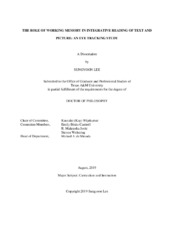| dc.description.abstract | Despite beliefs about the effectiveness visualization has on learning, researchers have found that adding pictures to text does not always lead to better learning outcomes. Although extensive empirical research has examined the relevant factors that can enhance the effects of images added to text, individual differences in underlying cognitive capacities are relatively unexplored in the literature. As such, the purpose of this dissertation study is to examine the role of executive control in the integrative reading processes of elementary students as well as the learning outcomes of students who read illustrated scientific texts through the observation of their eye movement patterns. To achieve this goal, this study examines three research areas: the first investigates the unique, direct contributions of fourth and fifth grade students’ integrative reading of text and pictures as evidenced by eye movement patterns and the link to their learning outcomes, while controlling for contributions of working memory capacity. The second examines the unique, direct contributions of fourth and fifth grade students’ working memory capacity to their comprehension of illustrated science texts. The final study examines unique, direct contributions of fourth and fifth grade students’ working memory capacity to their reading processes, including text processing, picture processing, and the integrative reading of text and pictures. This dissertation is expected to contribute to the extant theoretical and empirical literature. First, the results supplement current theories of multimedia learning by specifying the role of attention shifting and inhibitory control. In the current multimedia learning theories, the role of executive control is not clearly determined. Findings in this study further examine the current cognitive model of text-picture integration by recognizing the significant role of executive control capacity in learners. Second, the results will extend current knowledge about elementary school students’ cognitive processes when reading illustrated science texts through the use of an eye tracking technique.
Finally, for the upper elementary students, who advance from the learning to read to reading to learn stage, identifying relevant cognitive factors in learning with visualizations will provide foundations for creating and delivering adequate interventions. | en |


